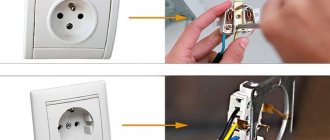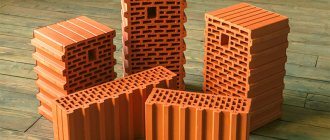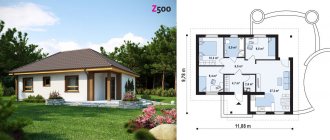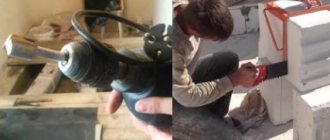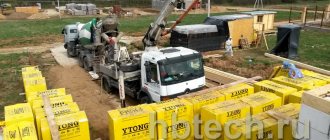To reduce heat losses in modern construction, block structures made of cellular concrete - gas silicate and aerated concrete, which have increased heat-insulating properties, are increasingly being used. These materials constantly compete with each other - they are often confused even by professionals due to the same characteristics and similar scope of application.
To answer the question: “What is the difference between aerated silicate and aerated concrete and what is better?”, let’s figure out what components these materials consist of, and then compare their pros and cons. But before that, it is important to clarify that gas silicate is one of the types of aerated concrete, only created by the method of forced hardening. It is the method of its production that affects the main characteristics of the finished products.
What is aerated concrete and gas silicate
These building materials are varieties of cellular concrete, which is characterized by a porous structure and low density. Durable and lightweight aerated concrete blocks have increased thermal insulation properties. The low thermal conductivity of cellular concrete is due to the presence of numerous voids filled with air.
Many people have a question about the difference between aerated concrete and gas silicate, what is the difference between them.
Both materials contain cement, sand, lime, gas-forming agents (aluminum paste or powder) and water. The difference is in the ratio of components and block manufacturing technologies.
Aerated concrete is a mixture whose main component is Portland cement. When the concrete mass, to which a gas-forming agent is added, hardens, spherical voids with a diameter of 1-3 mm are formed in it. The reason for their appearance is the release of hydrogen during a chemical reaction between aluminum and lime.
The composition of aerated concrete includes:
- Portland cement – 50-70%;
- Sand – 20-40%;
- Lime – 1-5%;
- Gas-forming agent – 0.04-0.09%;
- Water – 0.25-0.8%.
Construction of a house from aerated concrete blocks Source stroitelstvo-remont-sochi.ru
Gas silicate has a lime-silica binder base, consisting of silicate sand (up to 60%) and lime (24%). Aluminum powder or paste is also added to form cells.
Due to the difference in the content of cement and lime, products made from these materials differ in color. Aerated concrete blocks have a gray tint, while gas silicate blocks are white.
Construction of a wall from gas silicate Source blockexpert.ru
Differences in the production of cellular concrete
In the production of aerated concrete blocks, the main component is cement; in addition to it, they contain:
- lime;
- sand;
- water;
- aluminum powder (it is responsible for air bubbles).
An aerated concrete block can harden in a natural environment, as well as in special autoclaves. In the second case, the output aerated concrete blocks are almost white and acquire a large:
- strength;
- reliability;
- thermal insulation, etc.
Ready-made non-autoclaved aerated blocks are characterized by a gray color. Gas silicate also belongs to cellular blocks, but it has a slightly different composition. It contains:
- 62% - sand;
- 24% - lime;
- aluminum powder.
The solidification process takes place exclusively by force - in autoclaves, so at the exit the gas silicate blocks become white.
Foam concrete is obtained by mixing a cement base with special foaming agents necessary to foam the mixture. These additives can be based on both organic and synthetic substances. This mass is then placed in special molds to harden under natural conditions. This is how foam concrete is obtained. It does not have consistent strength over the entire surface. Foam concrete is a fairly fragile material, which negatively affects its transportation and laying. Gas silicate and foam concrete have different compositions and characteristics.
Technologies for manufacturing blocks from aerated concrete and gas silicate
To understand the difference between aerated concrete and gas silicate, it is necessary to take into account the difference in the methods of manufacturing such materials.
To obtain cellular concrete, 2 technologies are used: autoclave and non-autoclave.
In the non-autoclave production of porous blocks, solidification of the mass after adding a gas-forming agent occurs under natural conditions, without additional processing. It takes 28 days for the concrete to completely harden.
Autoclave technology allows you to speed up this process up to 12-15 hours by maintaining the concrete mass under a pressure of 8-14 atm at temperatures up to 175-190˚C.
The advantages of autoclave technology are:
- Possibility of giving gas blocks an exact geometric shape and standard dimensions;
- More uniform distribution of voids, enhancing heat and sound insulation;
- Increasing the hardness of blocks, reducing the likelihood of shrinkage and cracking of the material.
Warning! A significant disadvantage is the increased fragility of blocks processed in an autoclave. Special care is required when transporting and stacking them. To secure heavy objects on walls made of autoclaved aerated concrete, only anchor bolts with special spacers are suitable.
Reliable fastenings for aerated concrete walls Source eyecorrector.ru
The advantages of non-autoclave blocks are lower hygroscopicity and lower price.
Aerated concrete is made using both methods.
For the production of gas silicate, only autoclave technology is used.
See also: Catalog of companies that specialize in the construction of aerated concrete houses
Advantages of aerated concrete over gas silicate
The presence of a large number of pores in the gas slicate structure not only gives the block advantages, but also worsens some of its parameters. Due to its denser structure, aerated concrete has a high degree of moisture resistance and frost resistance. Therefore, excessive moisture and temperature changes do not destroy it from the inside.
High fire resistance allows a block of aerated concrete with a layer of plaster to withstand open fire without ignition for two hours. Autoclaved concrete has a worse ability. It is impossible to say unequivocally that savings when using aerated concrete are greater. Despite its low cost, it is smaller in size than gas silicate. The possibility of saving on adhesive material is eliminated if additional finishing is required to increase thermal insulation.
General advantages and disadvantages of aerated concrete and gas silicate
Aerated concrete or gas silicate have the same structure, due to which they have the following common advantages:
- Low thermal conductivity coefficient - from 0.09 W/m˟С (For comparison, it can be noted that for brick this figure is 0.5-0.8 W/m˟С).
- Good frost resistance (50 or more defrosting cycles).
- Lightness, strength, environmental friendliness, fire safety.
- Ease of processing blocks (cutting, grinding). A saw is used to cut aerated concrete and gas silicate.
Cutting aerated concrete blocks using a saw Source mtdata.ru
- Rapid formation of masonry.
Common disadvantages of aerated concrete and gas silicate are:
- The ability of porous blocks to absorb moisture well, the need to use special coatings to protect walls from dampness.
- Increased risk of damage to aerated blocks during transportation, storage and laying of walls.
- Possibility of shrinkage of materials by 1-3 mm as they dry. This process leads to a decrease in the strength of the masonry, the formation of cracks in the walls and the destruction of the plaster.
- Poor adhesion of concrete to binding materials used in creating masonry and finishing walls made of aerated blocks. There is a need to use adhesives with increased adhesion.
Damaged gas silicate blocks Source ytimg.com
Visual differences
At first glance at products made from cellular composites, it is easy to determine whether it is aerated concrete or gas silicate. Knowing that the aerated silicate block does not contain cement, and aerated concrete is formed with cement, which is the binder base, it becomes clear why there are differences in color:
- the white color of gas silicate blocks is associated with a high content of silicate (lime) and the absence of cement in the composite mass, which hardens using the autoclave method;
- The gray tint of aerated concrete is determined by cement, which is the basis of the massif, which acquires hardness naturally.
Depending on the concentration of cement, which is the basis of the aerated concrete block, and lime, which is part of the gas silicate, the products may have slight differences in color. There is a light gray palette of aerated concrete blocks, as well as gray and white shades of gas silicate products.
The difference between them lies in the quantitative content of raw materials and at what stage it enters the manufacturing process
Comparison of the properties of aerated concrete and gas silicate
When figuring out how aerated concrete differs from aerated silicate and what is better to use in the construction of various objects, it is necessary to compare the technical characteristics of these materials.
| Specifications | Aerated concrete | Gas silicate |
| Density, kg/cubic. m | 300-1200 | 300-1200 |
| Thermal conductivity, W/m˟S | 0,09-0,35 | 0,11-0,16 |
| Frost resistance (number of freeze-thaw cycles) | 25-75 | 25-150 |
| Shrinkage, mm/sq. m | 0,5 | 0,3 |
| Moisture absorption (% by weight of material) | 16-25 | 25-30 |
| Compressive strength, MPa | 1,5-2,5 | 1-5 |
| Compressive strength, MPa | 40 | 30 |
| Compressive strength, MPa | 190-250 | 190-250 |
How gas silicate blocks are produced
It is more advisable to buy gas silicate blocks from those dealers who represent products of well-known manufacturers. Modern high-quality equipment on factory lines allows for proper control over the quality of produced gas silicate blocks, thanks to which the buyer is confident in the durability of the purchased products.
The production process itself is divided into several stages, and, characteristically, each of them is fully automated. This eliminates the intervention of the human factor, on which the quality of the products often depends. Especially on Fridays and Mondays. Anyone who has worked in production will understand.
Lime, sand and gypsum are crushed, which forms the basis for the production of blocks. By adding water, the sand is ground to a liquid mixture. It is sent to a mixer, into which cement, gypsum and lime are added. Next, the components are mixed, and during this process an aluminum suspension is added to them.
After all the components have been thoroughly mixed together, the mixture is poured into molds, which are moved to the maturation zone. When exposed to a temperature of 40°C for four hours, swelling of the material occurs. In this case, hydrogen is actively released. Thanks to this, the final mass acquires the necessary porous structure.
Using a turning grip and a cutting machine, the blocks are cut to the required dimensions. At the same time, automation controls accurate and defect-free cutting of products.
Following this, the blocks are sent to an autoclave to gain their final strength. This process takes place in a chamber exposed to a temperature of 180°C for 12 hours. In this case, the steam pressure on the gas silicate should be at least 12 atmospheres. Thanks to this mode, the finished blocks gain the optimal value of final strength.
Thanks to the crane-divider and equipment for final quality control, the blocks are laid for their subsequent natural cooling. After that, possible contamination is removed from the blocks on an automatic line and the blocks are packaged and labeled.
What is noteworthy is that the production process is waste-free, since at the time of cutting, still at the hardening stage, the waste of the raw mass is sent for recycling, adding material to other blocks.
Pallets with packaged gas silicate blocks receive their own technical passport with detailed physical properties and technical characteristics of the product, so that the buyer can verify compliance with the declared characteristics.
Further work is up to dealers and marketers, on whom the success of product sales will depend.
Features of the use of aerated concrete and gas silicate blocks
When figuring out which is better - gas silicate or aerated concrete, and what is the difference between these substances, it is important to understand the features of their use. In this case, it is necessary to take into account not so much the difference in composition as the correct use of materials.
- For laying blocks of aerated concrete and gas silicate, a special adhesive mixture is used, which, in addition to cement and sand, contains additives that improve adhesion and accelerate the setting of the binder mortar;
- Considering the increased hygroscopicity of cellular concrete, façade walls made of aerated concrete must be plastered, covered with a layer of moisture-proofing putty, or other means used to protect external walls from precipitation. To make them less wet by rain, it is necessary to install an overhanging roof;
Original decoration of aerated concrete walls with bricks and porcelain tiles Source expertfasada.ru
- For insulation, painting or finishing of facades, it is necessary to use materials with good vapor permeability. At the same time, moisture will not be retained in the concrete blocks and the walls will not mold;
Characteristics Features
To answer the question of which material is better to use for construction, gas silicate or aerated concrete, let us dwell in detail on the characteristics of these cellular materials, each of which differs in properties, structure, and certain operational parameters:
- the strength characteristics of gas silicate exceed the strength of aerated concrete, which is associated with a more uniform concentration of air cavities in the concrete mass;
- gas blocks differ slightly from silicate composites in weight, which increases the forces acting on the foundation of the building and slightly complicates the work associated with masonry;
Gas silicate is a type of cellular concrete
- The thermal insulation characteristics of silicate concrete are higher than those of gas composite products, which is due to a more uniform concentration of air pores. This allows the use of gas silicate products for the construction of buildings with a comfortable temperature regime;
- Gas concrete has increased resistance to the effects of negative temperatures and long cycles of freezing and thawing, which is superior to silicate block, which is prone to intense moisture absorption;
- Unlike aerated concrete composites, silicate blocks have the correct geometry and are also characterized by reduced tolerances. This makes laying easier and reduces the consumption of adhesive mixture and plastering composition;
- the aesthetic perception of white buildings built from gas silicate is much higher compared to buildings made of gray gas-filled concrete;
- Aerated concrete has higher resistance to open fire, although both materials have good fire resistance;
- The service life of buildings based on gas-filled concrete and gas silicate blocks is quite long. Both materials are used in residential and industrial construction for a short period of time, so it is problematic to draw a conclusion about the durability of any of them.
Having listed the operational characteristics, you should focus on the financial side. With equal product sizes, aerated silicate products have a higher price compared to aerated concrete, which is due to the peculiarities of the manufacturing technology.
Video description
About whether it is possible to do without insulating walls made of aerated concrete - in the following video:
- Under aerated concrete and gas silicate blocks, waterproofing material must be laid on the foundation;
- To prevent shrinkage and destruction of the walls, during the laying of the blocks, reinforcement is made in the first and every fourth row, as well as in the area of window openings.
Reinforcement of a load-bearing wall during the construction of a house made of aerated concrete Source zaggo.ru
Where are gas silicate blocks used?
The scope of application of gas silicate lies in the following areas:
- thermal insulation of buildings,
- construction of buildings and load-bearing walls,
- insulation of heating networks.
In terms of their qualities, gas silicate blocks have much in common with foam concrete, but at the same time they surpass them in mechanical strength.
Depending on the density of the material. There are several areas of application:
- The density of the blocks from 300 to 400 kg/m3 greatly limits their distribution, and such blocks are more often used as insulation for walls. Their low density does not allow them to be used as a basis for walls, since they will collapse under significant mechanical load. But low density plays a role as insulation, since the more tightly the molecules adhere to each other, the higher the thermal conductivity becomes and it is easier for the cold to penetrate into the room. Therefore, blocks with low thermal conductivity provide more effective thermal insulation,
- blocks with a density of 400 kg/m3 have found their use in the construction of one-story buildings and work premises. Due to the increased strength of the blocks and their lower weight, the cost of arranging the foundation is significantly reduced,
- blocks with a density of 500 kg/m3 are more often used in the construction of buildings several floors high. As a rule, the height of the building should not exceed three floors. Such blocks, directly depending on the climate, are either not insulated at all or require traditional insulation methods.
- the best option for constructing high-rise buildings is to use blocks with a density of 700 kg/m3. This indicator allows the construction of high-rise residential and industrial buildings. Due to their lower cost, walls constructed from gas silicate blocks are replacing traditional brick and reinforced concrete walls.
The higher the density, the worse the thermal insulation performance, so such buildings will require additional insulation. More often, the external one is provided with the help of foam or polystyrene foam boards. This material has a low price and at the same time provides good thermal insulation of the room at any time of the year.
Recently, the position of gas silicate as one of the most popular materials in construction has strengthened significantly.
The relatively light weight of the finished blocks will significantly speed up the construction of the building. For example, gas silicate blocks, the sizes of which have standard values, according to some estimates, reduce the complexity of installation by up to 10 times compared to brick.
A standard block with a density of 500 kg/m3 and a weight of 20 kg can replace 30 bricks, the total mass of which will be 120 kg. Thus, installation of blocks on low-rise buildings will not require special equipment and will reduce labor costs and time spent on building construction. According to some estimates, time savings reach a 4-fold reduction in time costs.
Briefly about the main thing
When choosing competitive materials for the construction of low-rise and high-rise buildings, customers often have doubts: “gas silicate blocks or aerated concrete blocks - which is better, which are more suitable.
People compare the advantages and disadvantages of materials and focus on their technical characteristics. Take into account that gas silicate blocks are manufactured only in a factory manner and have more precise dimensions and shape.
Gas silicate has other advantages over aerated concrete (better heat and sound insulation, less hygroscopicity and shrinkage). However, price plays an important role.
Construction of objects from aerated concrete is cheaper. Considering that the difference in quality indicators is insignificant, many people prefer to buy aerated concrete blocks.
When purchasing materials, it is especially important to take into account building codes and recommendations of specialists.
Ratings 0
Some features of working with materials
Aerated concrete blocks are characterized by slight shrinkage, namely their dimensions are slightly reduced. However, it must be taken into account that this ability is noted immediately after its manufacture or installation. Therefore, it is not recommended to rush to build, otherwise defects, distortions and cracks may appear on the constructed buildings. This is due to the fact that the source material shrinks.
Taking into account the nature and need for the specific construction of buildings, it is necessary to purchase aerated concrete or gas silicate blocks. For example, when it is necessary to build the walls of a building that should allow as little sound as possible, it is incorrect and unwise to use gas-filled concrete. The fact is that this building material has a low ability to absorb noise and poor thermal insulation.
Gas silicate products are among modern building materials endowed with great functionality. The best technologies and high-tech equipment are used for their production. However, due to its hydrophobicity, this material is used mainly in the construction of internal partitions and walls in low-rise buildings, and only if the air humidity in the room does not exceed 60%. The service life of these different building materials, if used correctly, is quite long.
Advantages of gas silicate
This type of building blocks is popular. It is produced by using lime as the main binding element and is processed using the autoclave method. Its advantages include the following properties
- Strength. Thanks to the technology of creating blocks, air bubbles are evenly distributed throughout the entire volume, which allows the gas silicate to have high strength properties. It is less prone to cracks and shrinkage.
Given the same density indicators, aerated silicate products have a strength level 1.5 times greater than aerated concrete.
- Noise insulation. Due to the presence of an increased number of pores inside the materials, it has good noise insulation properties;
- Specific gravity. Due to the smaller mass of such blocks, their use requires less requirements for the bearing capacity of the foundation. This makes it possible to reduce the cost of construction when using them;
- Block shape. Due to the fact that after autoclave processing the material is cut to obtain the required dimensions, permissible deviations do not exceed 3 mm;
- Aesthetics. Buildings constructed from white gas silicate have a more attractive appearance.
Manufacturing of gas blocks
The methods for producing aerated concrete and gas silicate are similar. They consist of mixing ingredients, molding and hardening. The only difference is in the binding components.
| Components | Aerated concrete | Gas silicate |
| Sand, water | + | + |
| Lime | + | — |
| Metallic aluminum | — | + |
| Cement | + | + |
The table shows that lime is a gas-forming agent for aerated concrete, and aluminum powder is a gas-forming agent for silicate block.
All components of aerated blocks must be crushed as much as possible. The smaller the particles, the stronger the concrete.
As mentioned above, blocks are autoclaved and non-autoclaved. The goal of the autoclave method is to quickly gain strength and save time for hardening. If we talk about foam concrete, it also saves cement.
It is impossible to visually distinguish blocks from different methods, so it is better to buy material from reputable manufacturers in the construction market.
After autoclave treatment, the monolith is cut with a special string into blocks of the required size. Place on pallets and leave for 28 days to dry completely. After this, the blocks are ready for construction.
Types and scope of application of gas blocks
Depending on porosity, shrinkage, strength, gas silicate and aerated concrete blocks are distinguished by types and markings:
| Purpose of aerated block | Brand according to GOST | Application area |
| Structural | D1000 – D1200 | Used in the construction of multi-storey buildings |
| Structural and thermal insulation | D500 – D900 | You can build buildings no higher than the 3rd floor |
| Thermal insulation | D300 – D500 | Used only for wall insulation |
Gas silicate or aerated concrete blocks are used mainly in low-rise construction. They are used to build residential buildings, dachas, garages, bathhouses, and outbuildings. They are used both for external walls and for internal partitions of load-bearing and non-load-bearing walls. Also used as insulation.
You cannot use aerated blocks when constructing a plinth due to their high water absorption.
Fences are often built from gas silicate blocks. This fence is durable. The fence is quickly erected due to its large size. The main condition is the presence of a concrete foundation and waterproofing on top of it.
Aerated concrete or gas silicate - why they are confused with each other
These two types of blocks belong to cellular or lightweight concrete. Based on their scope of application and similar properties, they are often confused with each other. Both materials are very similar in structure, so not every specialist will be able to immediately distinguish them, not to mention ordinary people. Often this is also the fault of the manager, who positions the material under the general name of aerated concrete, without highlighting the differences.
Therefore, most buyers believe that different names are designations of the same material.
Developers make a huge mistake when they turn to private teams or migrants. These categories have a superficial knowledge of aerated concrete and aerated silicate and what the difference is between them.
General characteristics include:
- light in weight;
- porous structure;
- geometrically even shape, convenient for construction;
- low cost;
- qualitative indicators.
Market analysis of recent years shows that both types of blocks are in equal demand.
This is due to the fact that active propaganda and advertising purposefully paves the way for materials to construction projects at all levels: from one-story houses to multi-story construction.
Which block to choose for construction
When determining what is best for building a house, experts recommend choosing gas silicate, which is superior to aerated concrete in many respects. This is due to the fact that silicate materials are made at special enterprises where the quality of the products is closely monitored. For this purpose, special equipment is used, and laboratory tests are also carried out. But this affects the price, which makes the material more expensive.
However, the use of such material for load-bearing walls in buildings with more than 2 floors is not recommended.
Many multi-apartment developers, due to greater availability and low hygroscopicity, prefer aerated concrete. It is used for the construction of walls in monolithic frame structures. The use of each material is possible for the same purposes, subject to compliance with technological requirements. In total, such products are used in the following areas:
- Low-rise housing construction;
- Construction of industrial or commercial facilities;
- Construction of sports facilities;
- Construction of public buildings.
- The scope of application of such blocks is determined by weight and strength:
- Heavy options with high density can be used for the purpose of erecting capital walls or partitions in low-rise construction;
- Average in terms of performance, the product is structural and thermal insulating. Therefore, they are used for the construction of private small houses or cottages;
- Products with low strength are preferably used to create thermal insulation, and their use for the construction of loaded structures is prohibited.
The difference between aerated concrete and gas silicate is the technology for creating such blocks and their main characteristics. Everyone determines for themselves which building material is more preferable for the construction of a particular building. It is important to be based on the technical characteristics of the materials and financial capabilities.


